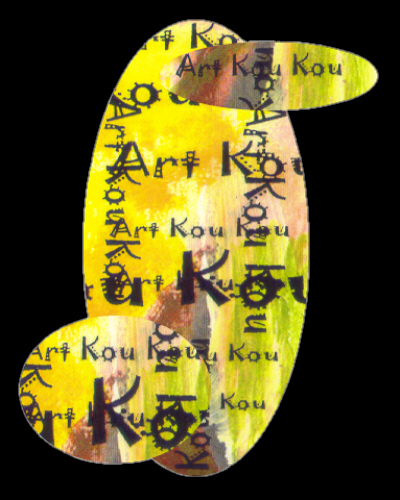I have been creating two-dimensional (2-d) art for most of my life - mostly photographs and pictures since I was about 3.† I have worked with finger paints, crayolas, oils, pastels, acrylics and water colors.† About 10 years ago I shifted to using computer photo-editor programs like Photoshop and using plug-ins like Kaiís Effects.† I have also worked with video, another 2-d form.† Recently I started working with 3-d computer art and I am very excited by it.† 3-d has major implications for creators of 2-d art.†
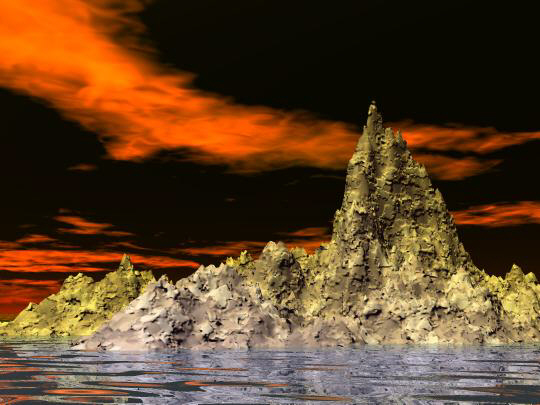 If you are good at using a photo-editor and are willing to learn
something new, you can use 3-d techniques to extend, give depth to, and liven
up your 2-d art.† And you can send your
productivity way up while having lots of fun and excitement.† That is why I am writing this simple
introduction to 3-d, specifically for curious 2-d artists.†
If you are good at using a photo-editor and are willing to learn
something new, you can use 3-d techniques to extend, give depth to, and liven
up your 2-d art.† And you can send your
productivity way up while having lots of fun and excitement.† That is why I am writing this simple
introduction to 3-d, specifically for curious 2-d artists.†
2-d art shows scenes from one perspective, examples being photographs and paintings.† They also show only the part of the scene that is in the painting or photo, and show it from only one viewpoint under one particular condition of lighting.† 2-d art is normally directly created using a camera, paints, etc.† What is shown in movies and TV is also 2-d art at any instant, though the camera can move, zoom and pan.
We naturally see objects in stereo with a perception of depth, because our two eyes see slightly different images.† Stereo technology for viewing photos goes back over 100 years, and new electronic stereo technologies are coming in the market now.† When I talk about 3-d I am referring to something else, not stereo which is 2-d seen with depth.
3-d conventional art works with objects that can be seen from many different perspectives and that can be textured and lit many different ways. †Sculpture and architectural construction are traditional 3-d art forms as are pottery, puppetry and wood carving.† Once you have a piece of 3-d art you can make many different 2-d renderings of it, such as by taking photos of a sculpture from different angles using different lighting conditions.
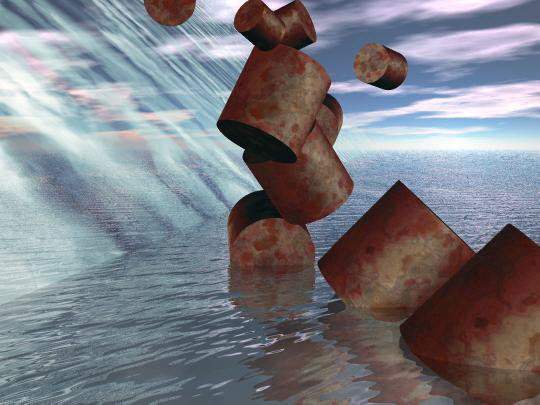 3-d computer art also works with
objects that can be seen from many different perspectives and that can be lit
many different ways.† They are virtual
objects in a computer, models which can be very simple or very complex.† In addition, 3-d virtual objects can easily
be surface-textured in different ways.†
They can be made shiny, reflexive or translucent, for example.†† Once an artist has developed a 3-d model,
he can also make many alternative 2-d renderings of it, snapshots of his model
so to speak.†
3-d computer art also works with
objects that can be seen from many different perspectives and that can be lit
many different ways.† They are virtual
objects in a computer, models which can be very simple or very complex.† In addition, 3-d virtual objects can easily
be surface-textured in different ways.†
They can be made shiny, reflexive or translucent, for example.†† Once an artist has developed a 3-d model,
he can also make many alternative 2-d renderings of it, snapshots of his model
so to speak.†
For example suppose you make a model of a field with a lake in it, with mountains in the background and a stormy sky.† This is something quite easy to do.†† Then, since it is a 3-d model you can make 2-d image snapshots of it from all kinds of different perspectives,say from above with the back of the mountains in the foreground and the lake in the background.
And you can do much more.†You can add a cabin in the field.† Using fractal algorithms you can change the nature of the terrain making it rough and rocky, put snow on the mountains, cover the ground with different kinds of grasses or trees, give the cabin a stone roof, alter the cloud and color composition of the sky, see the scene with proper reflections and shadows at dawn, dusk or at moonlight.† You can see the scene looking out of the window in the cabin.† Want to see your scene by light of a quarter-moon, starlight, or just at the crack of dawn?† Zoom in to details?† Zoom out to the horizon?† View the scene as a small animal in a tree would see it?† Make the sky red and cast a red pall on everything?† No problem.† A few keystrokes.†
A single 3-d model thus can be used to produce dozens of scenes of 2-d computer art.† These can either be complete scenes or backgrounds for further 2-d art.† Or, a unique background can be printed out on canvas in high quality, and the painting then finished in oils.† For me, it is frequently easier to get varied and interesting backgrounds this way than to paint even one of them.† This is true for the class of scenes that are easy to model in 3-d.† That is the advantage of 3-d for 2-d computer artists.
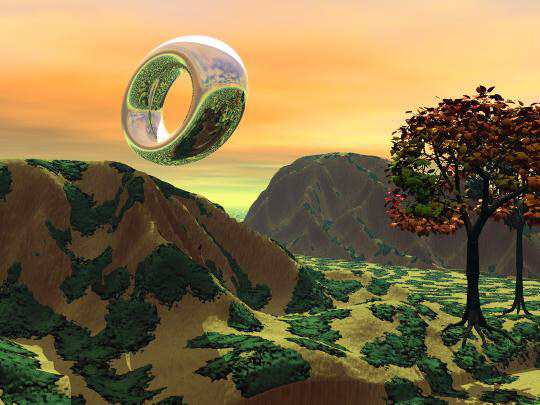 It is easy to include a number of
fantasy objects along with real ones in a 3-d model, like a glistening flying
saucer that shows a reflection of the terrain it is flying over.† And, with a little skill, you can use your
photos or 2-d art to give surface characteristics and textures to the 3-d
objects you generate.† You can make a
photo of a friend into a 3-d face, for example.† Then you can generate alternative 2-d viewpoints of that face.
It is easy to include a number of
fantasy objects along with real ones in a 3-d model, like a glistening flying
saucer that shows a reflection of the terrain it is flying over.† And, with a little skill, you can use your
photos or 2-d art to give surface characteristics and textures to the 3-d
objects you generate.† You can make a
photo of a friend into a 3-d face, for example.† Then you can generate alternative 2-d viewpoints of that face.
A 3-d model is made up of objects, in the case of the earlier example, say, a lake object, two different field objects, three mountain peak objects, a cabin object and a sky object.† Each of these objects are placed by the artist in the model in a desired geometric relationship, and each can be textured differently.† In building the model, the artist actually has to look at it from different perspectives via the computer to make sure that the spatial relationships are what he or she wants.
Natural objects like terrain, sky, fields, clouds, fog, smoke, fire, trees and grasses, waves and water effects are easy to model using 3-d, for there are fractal algorithms which can generate them.† In fact, using a fractal algorithm you can generate a stand of trees of a given kind, each one different in its branching structure, with no two trees or even leaves exactly alike.† This is the relationship between fractal art and 3-d modeling like that often expressed in Art KOU KOU.† In addition, 3-d modeling software programs offer large number of modifiable preset textures, and many more can be downloaded free from the Internet.† Or, you can make textures using your photo-editor program and then import them into your 3-d modeling program
A scene like a city street with cars, people, buildings and stores is much more complex, perhaps consisting of hundreds of objects.† And some of those objects, such as people, are in themselves very complex.† Complex objects may incorporate simpler objects in layers.† For example, a house object may include a porch object which includes window objects and railing objects.† 3-d modelers have developed large libraries of objects that can be incorporated by a new 3-d artist.† Some of these like houses, simple buildings and airplanes can be downloaded free from the Internet.† Other more sophisticated objects are sold, and some of the most sophisticated objects of all, including realistic virtual animals and people, are closely-held proprietary property of the 3-d animation houses that made them.†
You can build your own complex objects if you like, but you have to be careful and skillful about geometrical relationships among the constituent objects.† A badly-built house may look absolutely fine from one perspective, but look like the back of a movie set house from another perspective, and like jumbles of geometric shapes from most other perspectives.† A well-built house will look like a house from any perspective.† In this respect, 3-d art is more like sculpture or architecture than painting.†† The artist has to think and work in three dimensions.
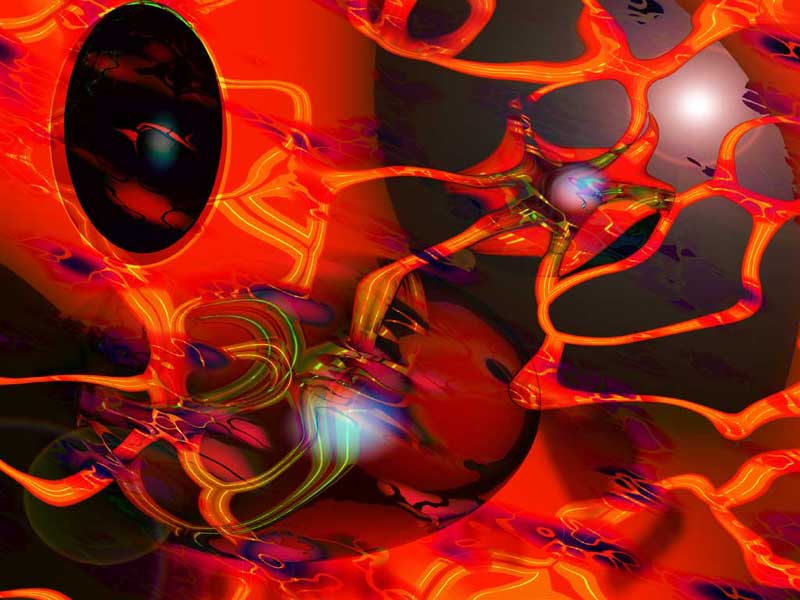 The possibility for creating near-real, surreal, and outright fantasy objects and scenes using 3-d are endless. One may work with biological,architectural, natural, human, or fantasy forms.
The possibility for creating near-real, surreal, and outright fantasy objects and scenes using 3-d are endless. One may work with biological,architectural, natural, human, or fantasy forms.
3-d modeling for artists is built on 3-d CAD-CAM (Computer Aided Design/Manufacturing) technology developed over the last 30 years.† 3-d software tools allow looking at and constructing objects from every conceivable direction. †Surfaces can initially be represented by shapeable wire frames which are then covered by textures.† Once a model is created, say of a garden with a winding path in it, it is fairly easy to animate the scene, for example showing what the garden looks like while walking along the path.† Position of the sun and the clouds in the sky can also change while taking the walk.† Textures can also be animated, so you can have ice crystals on the garden flowers dissolving as the rising sun heats them up.†
3-d is rapidly becoming a multi-billion dollar art form.† The main applications of 3-d art are creation of objects, scenery and characters for films, TV, and video games.† Of course, the field is related closely to 3-d architecture and 3-d CAD-CAM design, where the model might be for the interior of a building, a mechanical part, or even a whole automobile.†
An immense amount of 3-d scenery is being created for the on-line multi-party game industry, itself a multi-billion dollar industry with millions of players.† The Everquest games of SONY are examples.† Business based on 3-d art is growing as fast as Internet was growing about 1995, and is about in the same stage of development.†† 3-d is also of ever-increasing sophistication.† The new Matrix Reloaded film intermixes film with 3-d animations of the same characters.† It is virtually impossible for the viewer to know when the character shown is filmed or when it is an artist-enhanced 3-d rendition.
3-d modeling exists on many levels of sophistication† The technology is constantly developing at the high end with new techniques coming into use such as NURBS (Standing, as may not be completely obvious, for Non-Uniform Rational B-Splines).
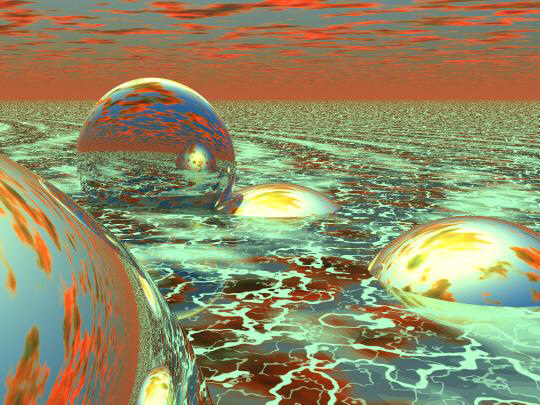 The beginning 3-d artist can get
started with PC or Mac software packages costing less than $100.† I use Bryce 5, which can be
purchased for about $160 after doing a little shopping around.† One of the most sophisticated package in
regular commercial use is 3-d max 5, which goes for nearly $6,000.† Lightwave is another package with cost
between these two and is extensively used for video animation.† And there are many others, including ones
specialized in various ways such as Poser which is used for creating people characters.
The beginning 3-d artist can get
started with PC or Mac software packages costing less than $100.† I use Bryce 5, which can be
purchased for about $160 after doing a little shopping around.† One of the most sophisticated package in
regular commercial use is 3-d max 5, which goes for nearly $6,000.† Lightwave is another package with cost
between these two and is extensively used for video animation.† And there are many others, including ones
specialized in various ways such as Poser which is used for creating people characters.
These software programs are actually reality-modeling programs in that they incorporate many of the mathematical laws of physics including 3-d projective geometry, optics and optical effects like reflection and refraction, the optical properties of physical surfaces, and fractal geometry.
Many of the 3-d software packages used by artists also offer possibilities of animation, and are thus actually can create 4-d models, the additional dimension being time.†
True 3-d artistry takes a lot of learning and skill.† I am still in elementary school as far as 3-d is concerned.† Fortunately however, 2-d artists like myself who wants to use 3-d mainly to help make 2-d art can get started with learning only a small fraction of the functionality of even a relatively inexpensive package like Bryce.† If you are good at making art with Photoshop and are open to something new, I suggest you try 3-d.† The initial learning curve is steep, but once you get to the first learning plateau you will probably find it very worthwhile.† And you will probably want to keep climbing higher
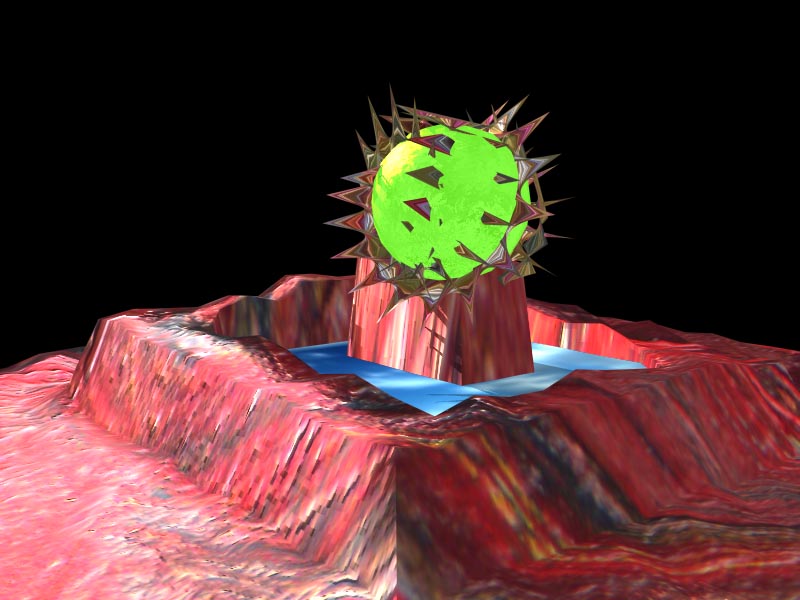 And yeah, you might need to
upgrade your computer horsepower.†
Making a 3-d model does not take much computer power but rendering it
into a high-resolution image can take hours on a slow machine.† The rendering changes the abstract
mathematical representations into an image.†
It includes generation of objects, fractal processing, application of
geometrical laws, and also a technique called ray-tracing which makes sure that
lighting, shadows and reflections are realistic for the specified lighting
conditions as they would be in nature.†
Even on a faster machine, rendering a complex hi-res scene can sometimes
take overnight.† You need not only a
fast processor but lots of RAM memory and a lot of available disk space.
And yeah, you might need to
upgrade your computer horsepower.†
Making a 3-d model does not take much computer power but rendering it
into a high-resolution image can take hours on a slow machine.† The rendering changes the abstract
mathematical representations into an image.†
It includes generation of objects, fractal processing, application of
geometrical laws, and also a technique called ray-tracing which makes sure that
lighting, shadows and reflections are realistic for the specified lighting
conditions as they would be in nature.†
Even on a faster machine, rendering a complex hi-res scene can sometimes
take overnight.† You need not only a
fast processor but lots of RAM memory and a lot of available disk space.
I have attached a small gallery of 2-d images rendered from 3-d models.† The four images that are mine were easy for me to build.†† Sea Peaks is a terrain distorted into a mountain with a fractal texture.† The ocean, sky, clouds, and fog, are also fractal-based.† You can see how the lighting is from the front horizon, how the island is reflected in the water, and how the water also picks up color elements from the sky.† The Visit consists of landscape, tree and sky objects, and a torus-shaped UFO object with a reflexive surface.† You can see from the shadows how the lighting is early dawn with the sun coming up behind the mountains.† Alien Spheres consists of replicated sphere objects, again with fractal textures, sky and ocean.† The shiny spheres reflect the strange-textured water and the red-streaked sky.† The water also picks up subtle reflections from the sky.† The sphere objects are to varying degrees sunk in the ocean.† It is also possible to render this model from a perspective below the ocean, looking up at the spheres and sky from under the water.† Falling Corks consists of ocean, sky and cork objects.† I made a single cork object, textured it and replicated it to get the others, then rotated and positioned each differently.† The falling rain effect consists of a second ocean plane, semi-transparent, and positioned at an angle.
The two works by Loren Lasher in the Gallery, Neuropolis and Hatchling, represent different 3-d styles and illustrate additional possibilities.
My gallery Reality Check mixes and matches 3-d and 2-d art elements
There are many Internet sites where you can see good examples of 2-d art derived from 3-d models, for example there are the great images in the Dante Gallery by David Camp http://www.esotericart.com/DavidCamp/. Click on Inferno.† And look at Loren Lasherís deadly chain at http://www.animedia.us/image/art8-00.gif.† And their are Caplyn Dor's wonderful works. A little browsing will reveal many others.
To the Art KOU KOU home page